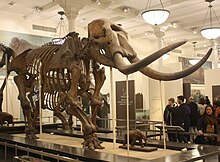
Back مستودون Arabic Mammut AST Mastodon Azerbaijani Мастодонти Bulgarian Mastodont Breton Mastodont Catalan Mastodon CEB Mastodont Czech Mastodont Danish Mammut (Gattung) German
| Mastodon | |
|---|---|

| |
| Mounted M. americanum skeleton ("Warren mastodon"), American Museum of Natural History | |
| Scientific classification | |
| Domain: | Eukaryota |
| Kingdom: | Animalia |
| Phylum: | Chordata |
| Class: | Mammalia |
| Order: | Proboscidea |
| Family: | †Mammutidae |
| Genus: | †Mammut Blumenbach, 1799 |
| Type species | |
| †Elephas americanus (= †Mammut americanum) Kerr, 1792
| |
| Other species | |
Species pending reassessment
| |
| Synonyms | |
|
Genus synonymy
Synonyms of M. americanum
Synonyms of M. matthewi Synonyms of M. vexillarius
Synonyms of M. raki
Synonyms of M. nevadanum
Synonyms of M. cosoensis
Synonyms of "M." borsoni Synonyms of "M." obliquelophus
| |
A mastodon (mastós 'breast' + odoús 'tooth') is a member of the genus Mammut (German for "mammoth"), which strictly defined, was endemic to North America and lived from the late Miocene to the early Holocene. Mastodons belong to the order Proboscidea, the same order as elephants and mammoths (which belong to the family Elephantidae). Mammut is the type genus of the extinct family Mammutidae, which diverged from the ancestors of modern elephants at least 27-25 million years ago, during the Oligocene.
M. americanum, known as an "American mastodon" or simply "mastodon," had a long and complex paleontological history spanning all the way back to 1705 when the first fossils were uncovered from Claverack, New York in the American colonies. Naturalists struggled to explain the affinities of the proboscidean because of its uniquely shaped molars, which have no modern analogues in terms of large mammals. The American mastodon caught the attention of not only European researchers but also influential Americans before and after the American Revolution. American historians of the 21st century have argued that findings and displays of its fossils had helped to bolster American nationalism and contributed to a greater understanding of extinctions. It is known by many skeletons which are now typically on display in American museums, a trend first started by Charles Willson Peale in 1804.
Taxonomically, M. americanum was first recognized as a distinct species by Robert Kerr in 1792 then classified to its own genus Mammut by Johann Friedrich Blumenbach in 1799, thus making it the 2nd fossil mammal genus to be erected with an undisputed taxonomic authority. However, the original genus name was overshadowed by "Mastodon" in the 19th century, which was established formally by the French naturalist Georges Cuvier in 1817. The genus became problematic as it served as a wastebasket taxon for over 20 fossil proboscidean species whose dentitions more closely resembled that of M. americanum than those of elephantids or deinotheres up to the early 20th century. After major revisions of proboscidean taxonomy, the genus Mammut today is defined as the valid genus name and includes 7 definite species, 1 of questionable affinities, and 4 other species from Eurasia that are pending reassessments to other genera.
As a member of the Mammutidae, it is defined by its molars which have a zygodont morphology (where the cusps of the teeth are merged into ridges) which have remained evolutionarily conservative (little changed) throughout the evolution of the family. In comparison to its likely ancestor Zygolophodon, Mammut is evolutionarily derived with a reduction to loss of the lower tusks, shortening of the mandibular symphysis (the frontmost part of the lower jaw), and particularly long and upward curving upper tusks. As a result of its conservative evolutionary history, Mammut consistently occupied specializations to browsing on leaves, fruits, and woody plants. This allowed mastodons to niche partition with other members of Proboscidea in North America, like gomphotheres and the Columbian mammoth, who had shifted to mixed feeding or grazing by the late Neogene-Quaternary. Mammut as a result was a highly successful proboscidean that had achieved maximum diversity in the Pliocene then is known from abundant fossil evidence in the Late Pleistocene. It is thought to have had behaviors not much different from elephants and mammoths, living in herds, displaying strong degrees of sexual dimorphism, and entering phases of aggression under musth in the case of males.
Archeological evidence reveals that mastodons for at least a few thousand years coexisted with Paleoindians, who were the first humans to have dispersed to North America and at least sometimes hunted them based on kill sites found in both pre-Clovis and Clovis cultural phases.
Mastodons disappeared along with many other North American animals, including most of its largest animals (megafauna), as part of the Late Pleistocene extinctions around the end of the Late Pleistocene-early Holocene, the causes typically being attributed to Clovis culture hunting, severe climatic phases like the Younger Dryas, or some combination of the two. The American mastodon has a last recorded occurrence in the earliest Holocene around 11,000 years ago, which is considerably later than other North American megafauna species. Today, the American mastodon is one of the most well-known fossil species in both academic research and the public perception, the result of its inclusions in American popular culture.
© MMXXIII Rich X Search. We shall prevail. All rights reserved. Rich X Search